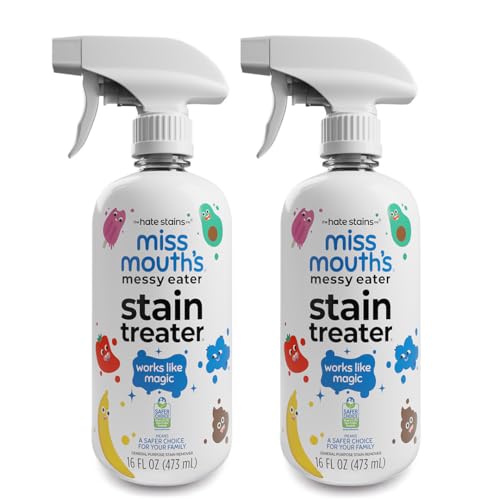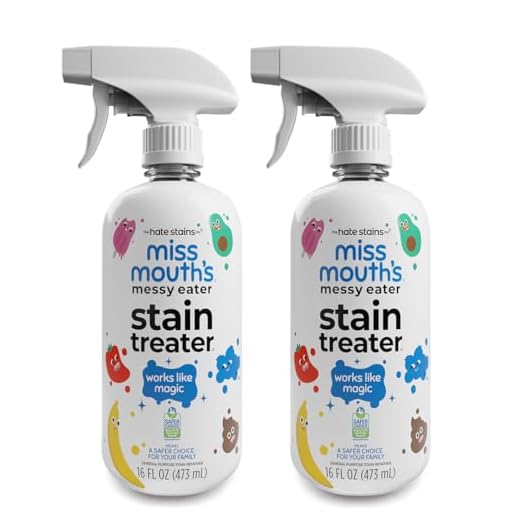



Immediately blot the affected area with a clean cloth or paper towel to absorb as much liquid as possible. Avoid rubbing, as this can spread the stain further. Once the excess has been removed, sprinkle salt generously on the stain. This will help draw out moisture and prevent the pigment from setting. Allow the salt to sit for several minutes.
Afterward, rinse the fabric under cold water from the back of the stain to push the residue out. If the stain persists, create a mixture of hydrogen peroxide and dish soap in equal parts. Apply this solution directly onto the stain and let it sit for about 30 minutes. Follow up by rinsing thoroughly with cold water.
For stubborn marks, consider using a specialized stain remover designed for delicate materials. Always test any product on a small, inconspicuous area first to ensure it won’t damage the fabric. Finally, launder the item as per its care label instructions, checking before drying that the stain is completely gone, as heat can set the stain permanently.
Immediate Steps to Take After a Spill
Act swiftly to minimize damage. Blot the area with a clean, dry cloth or paper towel to absorb as much liquid as possible. Avoid rubbing, as it can spread the stain further.
Next, sprinkle table salt generously over the affected area. The salt will help absorb the liquid. Allow it to sit for several minutes before gently brushing it off. This initial step can significantly reduce the stain’s intensity.
Prepare a mixture of cold water and a small amount of dish soap. Dampen a cloth with this solution and gently dab the stained area. Rinse the cloth frequently to avoid spreading the stain.
If available, apply a stain remover specifically designed for fabric. Follow the manufacturer’s instructions closely. Allow the product to sit for the recommended time before rinsing with cold water.
For persistent stains, consider using a mixture of hydrogen peroxide and dish soap in equal parts. Apply this solution carefully and allow it to sit for about 30 minutes. Rinse thoroughly afterward.
| Step | Action |
|---|---|
| Blot | Use a clean cloth to absorb liquid. |
| Salt | Sprinkle over the stain and let it absorb. |
| Soapy Water | Dab the area with a damp cloth and rinse. |
| Stain Remover | Apply according to instructions and rinse. |
| Hydrogen Peroxide | Mix with dish soap, apply, let sit, and rinse. |
Lastly, launder the fabric as per the care label instructions. Before drying, ensure the stain is completely removed. Heat can set the stain permanently.
Common Household Ingredients for Stain Removal
Baking soda serves as a powerful agent for tackling tough marks. Create a paste with water, apply it to the stained area, and let it sit for about 30 minutes before rinsing. This method is particularly effective for lifting residual discoloration.
White vinegar acts as a natural disinfectant and can neutralize pigments. Mix equal parts vinegar and water, dab onto the affected fabric, and blot gently. This solution can help in breaking down the stain without harming the material.
Lemon juice possesses natural bleaching properties. Combine it with salt for enhanced effectiveness. Apply the mixture to the stain and expose it to sunlight for a few hours, then rinse thoroughly.
Hydrogen Peroxide
Hydrogen peroxide, a common antiseptic, can work wonders on discolored fabrics. Dilute it with water in a 1:1 ratio, apply to the stain, and let it sit for a short period before rinsing. This method is especially useful for organic stains.
Dish Soap
A simple dish soap solution can effectively lift stains. Mix a few drops of dish soap with warm water, apply to the mark, and blot gently. This approach is safe for most fabrics while being tough on grease and other residues.
These household ingredients are readily available and can be effective allies against stubborn stains, providing a practical approach to maintaining fabric integrity.
Using Salt and Baking Soda for Stain Treatment
Immediately sprinkle salt on the affected area. Salt acts as an absorbent, drawing out moisture and pigment from the fabric. Allow it to sit for about five to ten minutes, then gently blot with a clean cloth to lift the stain.
Next, create a paste using baking soda and water. Combine three parts baking soda with one part water to form a thick paste. Apply this mixture directly onto the stained area. Let it dry completely before brushing off the residue. This method can help break down any lingering pigments.
Additional Tips
Testing the salt and baking soda mixture on a hidden seam or area of the fabric is wise to ensure no discoloration occurs. Always rinse the fabric with cold water after treatment to remove any remaining residue. If the stain persists, repeating the process may yield better results.
Final Steps
After treatment, laundering the fabric according to care instructions is essential. Avoid using hot water, as it could set any remaining stain. Instead, use cold water and a gentle detergent to maximize the chances of complete stain removal.
Best Commercial Stain Removers for Red Wine
OxiClean MaxForce is a powerful option, known for its ability to tackle tough stains, including those from dark liquids. Apply it directly to the affected area and let it sit for a few minutes before laundering.
Wine Away is specifically formulated for beverage stains. Spray it on, blot the area, and rinse with cold water. It’s effective and doesn’t bleach fabrics.
Shout Advanced Gel is another excellent choice. Its gel formula clings to stains, ensuring that it penetrates effectively. Apply it generously, allow it to sit, then wash as normal.
For a more eco-friendly solution, consider Biokleen Bac-Out Stain Remover. This product utilizes natural enzymes to break down stains. Spray it on the mark, let it work for a bit, and rinse.
Finally, for those who prefer convenience, Tide To Go pens are handy for on-the-spot treatment. Just press the tip against the stain and swipe across; it’s great for immediate action.
For a delightful culinary experience, explore how to cook fresh brussel sprouts in a skillet.
Washing Techniques to Ensure Stain Removal
Utilizing the right methods during the laundering process significantly impacts the success of erasing unwanted marks. Begin with cold water, as hot temperatures can set the stain further into the fabric. Rinse the affected area under cold running water as soon as possible to dilute the pigment.
Follow these steps for optimal results:
- Soak the fabric in cold water for at least 30 minutes to loosen the stain.
- Apply a pre-treatment solution directly to the mark. Gently rub it in with your fingers or a soft cloth.
- Wash the item in the washing machine on a delicate cycle, using cold water and a mild detergent. Avoid using bleach, as it can react with the stain and worsen the situation.
- Inspect the fabric before drying. If any trace remains, repeat the treatment and washing process. Do not dry until the stain is completely gone, as heat can make it permanent.
For delicate fabrics, consider hand washing instead. Use a gentle detergent and avoid wringing out the material, as this can cause damage.
Always check care labels for specific instructions and recommendations related to the fabric type. This will help maintain the integrity of the material while ensuring the stain is effectively treated.
Preventative Measures to Avoid Future Stains
Choosing the right attire significantly reduces the likelihood of mishaps. Opt for darker shades or patterns in environments where spills are likely. Consider wearing an apron or a designated wine bib during gatherings.
Protective Treatments
- Apply a fabric protector spray to garments before they encounter any potential spills. This creates a barrier that repels liquids.
- For upholstery, use a stain-resistant treatment to safeguard against future accidents.
Mindful Drinking Habits
- Hold glasses carefully and choose sturdy, wider bowls to minimize the risk of tipping.
- Limit the number of drinks placed near food to avoid accidental contact.
- Engage in slower, more mindful sipping, especially in crowded settings.
Utilizing coasters and napkins can further shield surfaces from unexpected drips. Always have a designated area for drinks to keep them away from high-traffic zones.
Regularly check for stains on garments and treat them immediately, even if they seem minor. Prevention is always more effective than dealing with a stain after it has occurred.








